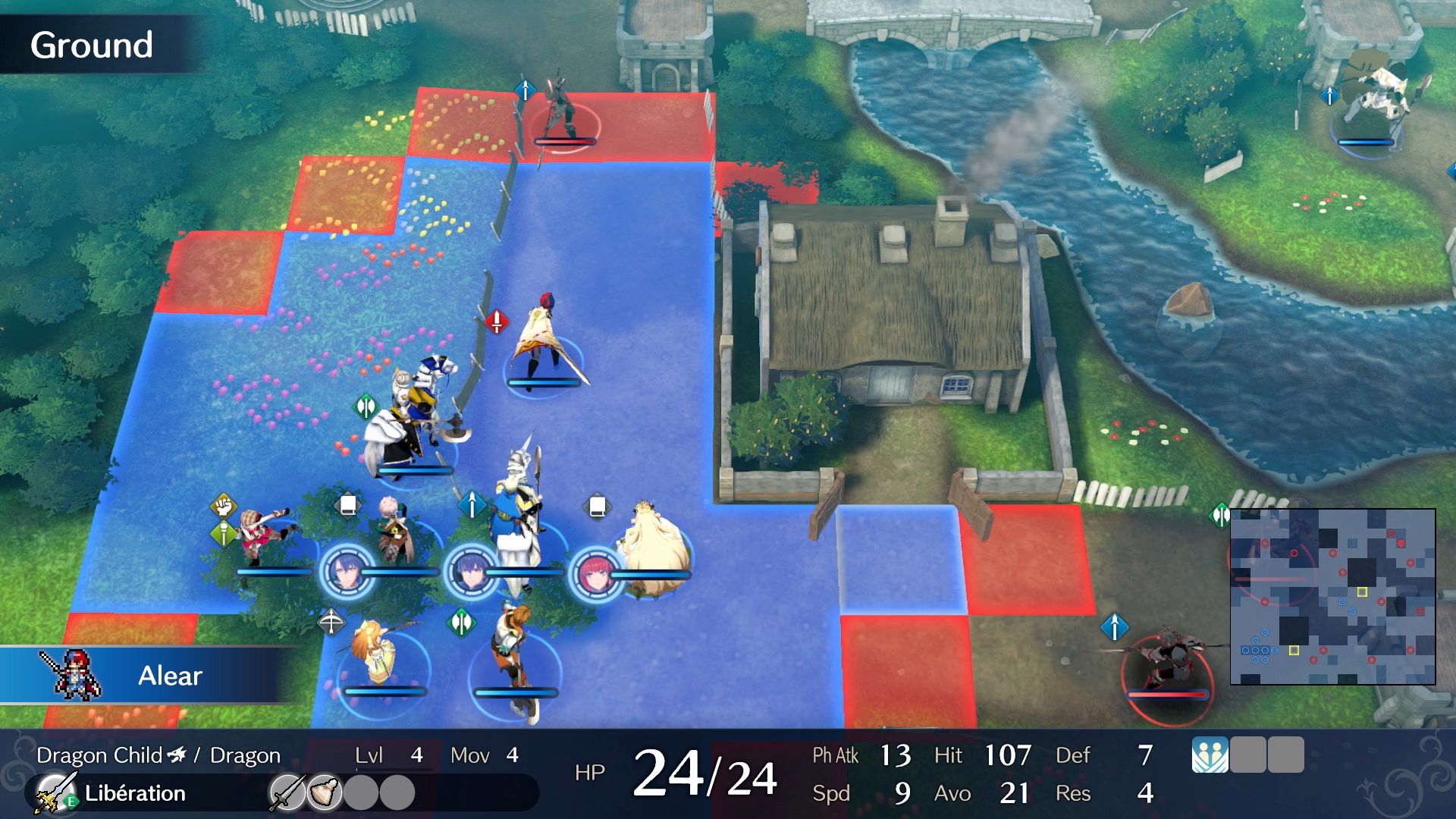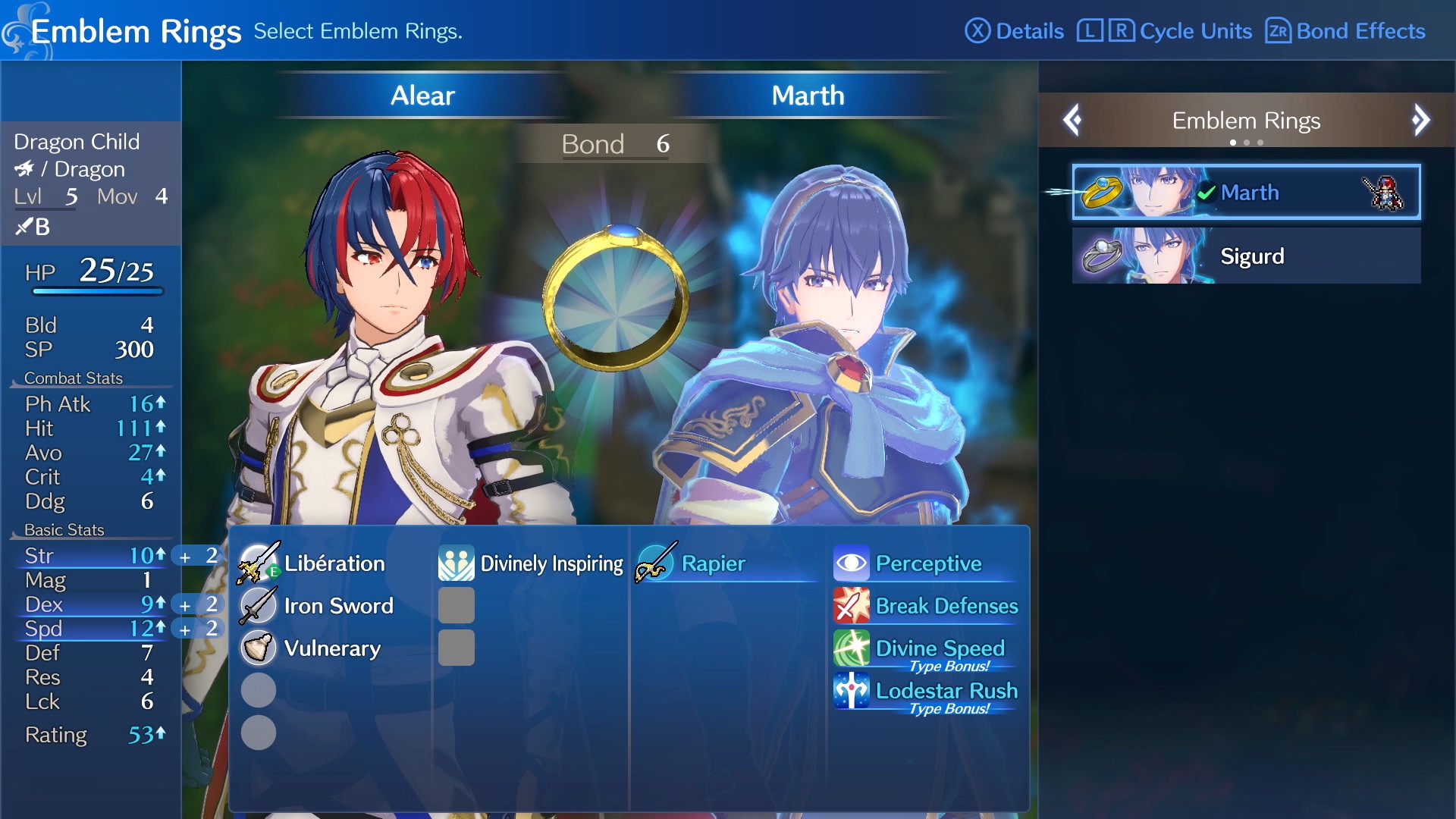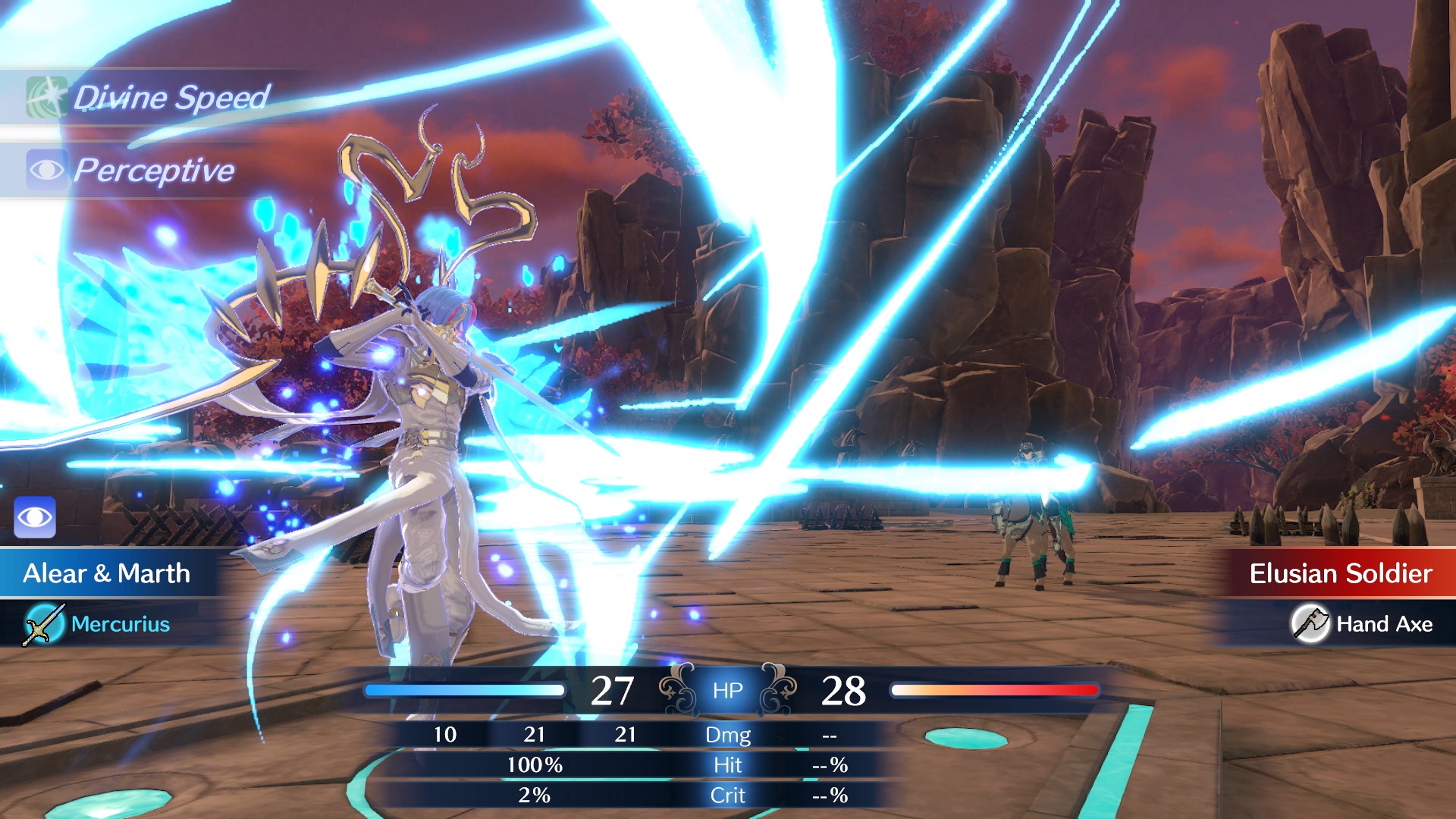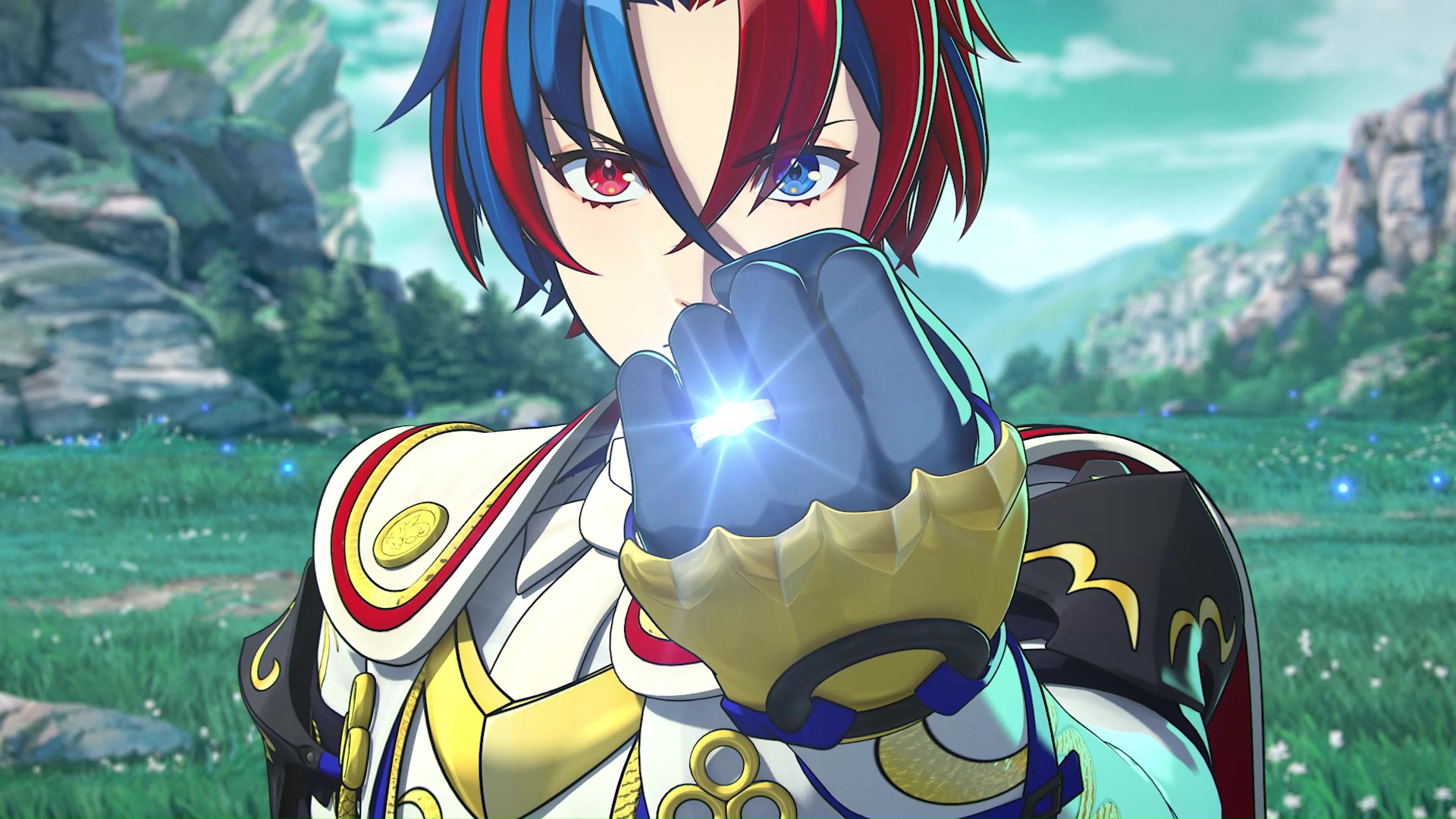
After an hour of meticulously making my way through the shimmering desert palace, I find myself in its illustrious throne room. But I have to be careful. Hovering above the throne is a winged sorcerer with debilitating long-range spells, while her equally powerful allies lie at the entrance. Since the room is relatively small and Permadeath is enabled, any wrong move could quickly send one of my party members to an untimely demise.
These nail-bitingly tense moments are at the heart of any Fire Emblem, and they’re arguably at their best in the long-running Nintendo series’ latest entry, developer Intelligent Systems’ Fire Emblem Engage. With an emphasis on expanding Fire Emblem‘s classic turn-based strategy mechanics and returning to a more traditional structure, Engage ultimately proves to be a winning experience beyond its narrative shortcomings.
A lack of Engage-ment
But first, let’s get the bad out of the way: yes, Engage‘s story and characters are a complete letdown. The last mainline Fire Emblem, 2019’s Three Houses, has become one of the most beloved Switch games, in no small part, due to its gripping narrative filled with three-dimensional characters grappling with issues like classism, PTSD and social anxiety. Other Fire Emblem modern entries, like Awakening and Fates, also had their own narrative hooks. What we get in Engage, though, is extremely thin. That starts with the protagonist, Alear (male or female based on your choice), who checks off two tired tropes: the “amnesiac lead” and “chosen one hero.” In this case, Alear is the Divine Dragon, a legendary hero who awakens from a 1,000-year slumber with no memories and a single goal: to stop the resurrection of the dreaded Fell Dragon. To do that, they’ll need to collect 12 ‘Emblem Rings,’ magical trinkets containing the spirits of classic Fire Emblem characters like Marth (Shadow Dragon and the Blade of Light).
As far as premises go, it’s pretty generic fantasy — the kind of thing you’d expect from an early Fire Emblem game, not one in 2023. That in itself wouldn’t be much of an issue if the characters themselves were strong, but unfortunately, they’re also lacking. It’s common for a Fire Emblem game to take an archetypal character and flesh them out through optional ‘Support’ conversations, but even those are woefully bland in Engage. Most of the time, they’re dull, surface-level exchanges that touch on characters’ shared love of exercise or food without digging deeper into who they are. Later-game plot twists make some characters more interesting, but overall, I was disappointed to find myself so disengaged on a narrative level.

Fire Emblem Engage’s characters just aren’t interesting at all.
This also makes Engage‘s home base, the Somniel, feel less compelling. Here, you can carry out stat-boosting workout minigames, train units in an arena, go fishing and more. To be sure, the admittedly simplistic nature of these activities offers a nice reprieve from the challenges of combat, and I appreciated how it’s smaller and more manageable than Three Houses’ sprawling and often unwieldy Garreg Mach Monastery. But without caring about the characters, I found myself spending as little time here as possible. This extends to the post-battle sections in which you can explore the maps in full 3D. It’s worth doing to appreciate Engage‘s remarkably sharp visuals and collect some loot, but the actual banter with characters here is, once again, just exasperatingly trite.
The saving grace for the narrative? It focuses on a single storyline. While Three Houses is one of my favourite games of all time, it definitely felt bloated due to a three-campaign structure that ostensibly required at least two 50-ish-hour playthroughs to truly grasp the bigger picture. The mainline Fire Emblem before that, 2016’s Fates, was even worse; you had to buy three games to get the full story. Engage, thankfully, does away all of that, giving you the complete experience within a single playthrough — one that graciously takes around 40 hours to beat, no less.
Those battles, though!

Engage’s real stories are the ones you make for yourself on the battlefield.
Despite all of this, I couldn’t stop playing Engage. Indeed, it’s a testament to the strength of the gameplay that the lack of an emotional investment in the story and characters didn’t kill my interest. That’s all thanks to the slew of smart refinements that tighten up the entire experience and deliver Fire Emblem‘s best gameplay to date.
Chief among these: the grand return of Fire Emblem‘s classic ‘Weapon Triangle,’ a rock-paper-scissors-style mechanic in which swords beat axes, axes trump lances and lances top swords. This was absent in Three Houses but is most welcome here; I’ve always appreciated how it requires you to apply a more chess-like thoughtfulness in how you deploy units. Sure, your sword-wielding Knight could easily take out that axe-equipped brute over there, but doing so would put him on the other end of a more mobile mounted unit’s lance. Adding another layer to the Weapon Triangle is the new Break status, which leaves the defending unit incapable of counterattacking for the duration of the turn. Both you and your opponent can take advantage of this, so you have to ensure you’re not sending out a unit to die. Conversely, it’s absolutely thrilling to have a small group Break and take down a tougher enemy without getting a scratch.
Exploiting the Break system without falling victim to it yourself is absolutely essential, especially in later fights like that aforementioned palace skirmish. In fact, Engage is quite challenging throughout, further adding to the game’s throwback feel. That said, the level of difficulty always feels well-balanced; appropriately tough without being punishing. One of Three Houses‘ additions, the limited-use ability to rewind turns to undo fatal errors, also makes a most welcome return here. Of course, you can still play on the lowest difficulty (Normal) and turn off Permadeath, but I kept that on and went with Hard (the middle option) and it was the perfect challenge.

Marth is the first of 12 Emblem Rings that you’ll get.
But it’s the central Emblem Rings that really spice things up. Mercifully, Engage isn’t the Genshin Impact-style gacha game it may appear to be; you unlock all 12 Emblem Rings naturally over the course of the story. With them, you can pair a classic Fire Emblem hero with one of your party members to give them a variety of buffs, special moves and powerful weapons. For example, Sigurd (Genealogy of the Holy War) is a mounted jouster, so you might want to give him to your lumbering, lance-wielding General for added mobility. On the other hand, you might want to play against type and have Lyn (The Blazing Blade) give your sword unit some longer-range bow abilities. You’ll also gain SP through the use of Emblems that can go towards permanently acquiring skills should you give the ring to someone else. This adds another level of thought to character progression; perhaps you want to have Lucina (Fire Emblem Awakening) paired with your low-defence healer to unlock agility-boosting skills to help them dodge otherwise fatal blows. It’s a cleverly intricate system that had me constantly mixing-and-matching characters and Rings when possible.
On top of that, you can ‘Engage’ with each Ring in battle to merge your Emblem and hero together in a gloriously over-the-top anime fashion. For three turns, you’ll unlock new skills, your Emblem’s signature weapon and, most notably, a special Engage Attack. The latter is a supermove that can only be used once per Engagement, so you have to think carefully about when to let one rip. As I acquired more Rings, I was impressed at just how varied these supermoves would be. Besides your standard flurry attacks (Marth’s Lodestar Rush), there’s the ability to teleport to another part of the map and fire off a powerful spell (Gaiden‘s Celica’s Warp Ragnarok), extremely long-range bow sniping (Lyn’s Astra Storm) and multi-weapon combo to maximize Break potential (Thracia: 776‘s Leif’s Quadruple Hit). My personal favourite? Great Sacrifice, a life-saving move from Radiant Dawn‘s Micaiah that drops the caster’s HP to 1 in exchange for fully healing the rest of the party. Once depleted, your Engage metre slowly replenishes through battle or by finding ‘Emblem Energy’ sprinkled throughout the map, which means you have to Engage more sparingly.

Engaging with a character is extremely anime in the best way possible.
I absolutely adored what these Rings bring to Fire Emblem‘s tried-and-true battles. The ways in which they can help you develop characters are staggering, which encourages a great deal of thought to go into how you build out each one. Further, the Engage mechanic feels like a genuine revolution of the character-pairing options of older Fire Emblem games, maximizing the potential of both unit and Emblem to give you an ace in the hole when needed. Balancing out these systems, however, is the fact that enemies will occasionally have Emblem Rings. While they don’t get the special abilities, they can execute Engage Attacks, adding a surprising, almost horror game-level of tension whenever I saw one appear.
With all of that said, focusing such a central gameplay mechanic on characters from the Fire Emblem games of old is a… strange choice. In particular, it highlights how many have never made it outside of Japan (i.e. Thracia: 776) or, worse, how Nintendo has failed to preserve those that did release overseas (like Path of Radiance) through a Virtual Console-like platform. This means that Engage‘s crossover appeal is frustratingly limited, as a significant percentage of players will have no attachment to the majority of these characters. Further, Engage‘s writing does little to flesh them out beyond some hackneyed dialogue; even Fire Emblem‘s classic Support conversations are reduced to extremely bland two-sentence exchanges with the Emblems. Look no further than Alear’s first conversation with Marth in which they ask how he’s so strong, to which Marth basically says “because the power of friendship.” (I kid you not.)
Put a ring on it

12 Rings to rule them all.
In the end, Fire Emblem Engage is in a rather tricky spot. Those who are coming in after Three Houses might find it difficult to adjust to the weak and unemotional writing. On the flip side, Fire Emblem veterans who prefer the focus on battles, character building and challenge will likely be happy to see less of an emphasis on story and social elements. As someone who holds Three Houses to be among his favourite games ever, this was certainly a challenge for me. But over time, I came to appreciate Engage for what it is: a brilliant strategy game with a deep and rewarding gameplay loop. In other words, it’s easily a must-play if you’re a fan of the genre, regardless of prior Fire Emblem experience.
Fire Emblem Engage will launch exclusively on the Nintendo Switch on January 20th.
Image credit: Nintendo
MobileSyrup may earn a commission from purchases made via our links, which helps fund the journalism we provide free on our website. These links do not influence our editorial content. Support us here.


